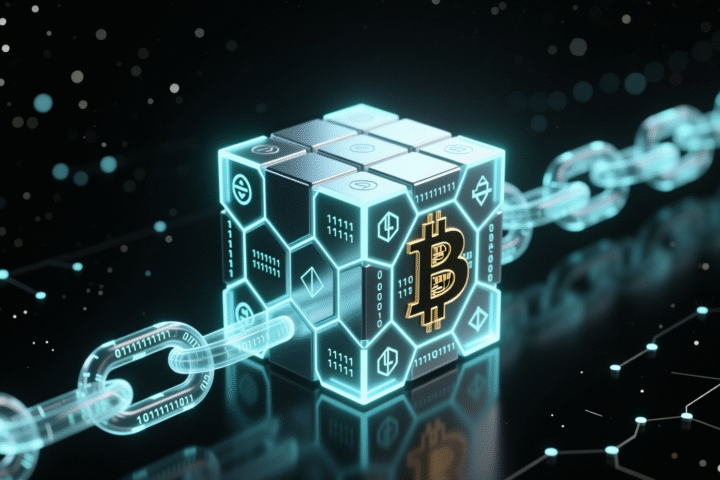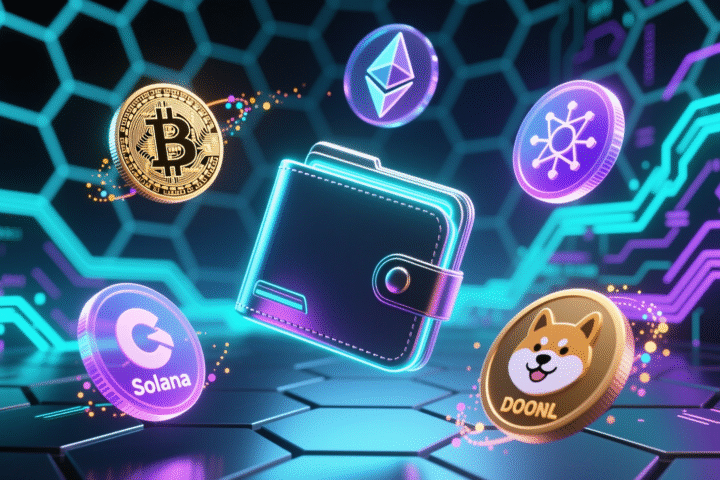The global banking system is like an old, slow computer — functional but frustrating. Transactions take forever, fees eat into your money, and security risks are everywhere. And let’s not forget financial exclusion — millions of people around the world don’t have access to basic banking services because of geography, documentation requirements, or high costs.
Enter blockchain, the tech that’s shaking things up. You’ve probably heard of it thanks to Bitcoin, but blockchain isn’t just about cryptocurrency. It’s a decentralized, secure, and transparent way of recording transactions—no middlemen needed. Instead of relying on banks to verify and process payments, blockchain does it automatically, cutting down costs and speeding up the whole process.
Sounds like a game-changer, right? But the big question is: Can blockchain actually fix the global banking system, or is it just another tech buzzword? Let’s break it down.
The Problems in Traditional Banking
If you’ve ever sent money internationally, you know the pain—waiting days (sometimes weeks) for your cash to arrive, only to realize a chunk of it disappeared into a black hole of fees. So, what’s the deal?
Slow Transactions: Why Does It Take So Long?
Banks don’t send money directly like texting a friend. Instead, they go through a maze of intermediaries—clearing houses, correspondent banks, and outdated systems. By the time your money reaches its destination, it’s taken a scenic route through multiple financial institutions, each adding delays.
High Costs: Fees, Fees, and More Fees
Ever checked your bank statement and wondered where your money went? Banks love charging fees for just about everything—wire transfers, currency conversions, account maintenance, even withdrawing your own money from the wrong ATM. And the less access you have to traditional banking (think rural areas or developing countries), the higher these costs tend to be.
Bottom line? Traditional banking is slow, expensive, and way more complicated than it needs to be. But what if there was a way to make transactions instant, low-cost, and hassle-free? That’s where blockchain steps in.
The Problems in Traditional Banking
The global banking system is like a clunky old computer—sure, it technically works, but it’s slow, expensive, and prone to crashing when you need it most. For decades, we’ve just accepted the frustrating reality of delays, hidden fees, and security risks. But why? Let’s break down the biggest headaches.
Slow Transactions & High Costs
Ever tried sending money to another country? It’s like putting your cash on a cargo ship and hoping it eventually shows up. International transactions can take days (sometimes even a week) because your money doesn’t travel in a straight line—it bounces between banks, each one taking a cut along the way. Even domestic transfers can come with annoying delays, especially on weekends or holidays.
Oh, and those fees? Banks don’t just charge for transactions—they’ll happily bill you for currency conversions, account maintenance, and even withdrawing your own money from the wrong ATM.
Lack of Transparency & Trust Issues
Banks hold all the power. They decide the rules, control the transactions, and often operate with minimal oversight. Ever been surprised by a hidden fee? Or heard about a financial crisis where big banks played risky games with people’s money? Traditional banking is built on trust—but history has proven that trust isn’t always earned.
Financial Exclusion: Not Everyone Gets In
For billions of people, having a bank account isn’t an option. Many banks require multiple forms of ID, proof of address, or a minimum balance—things that aren’t accessible to huge portions of the world’s population. Even if you qualify, banking services aren’t always nearby, especially in rural areas. In many places, access to financial services is a privilege, not a right.
Security Risks & Fraud
Banks might seem secure, but cybercriminals are always looking for ways to break in. Data breaches, hacking, and identity theft cost billions every year, and once your personal information is compromised, it’s tough to recover. Plus, ever had your card info stolen? It’s a nightmare trying to get your money back.
How Blockchain Addresses These Issues
So, traditional banking is riddled with problems—slow transactions, high fees, security risks, and billions left without access to financial services. Enter blockchain, the tech that promises to shake things up. But can it really fix these issues? Let’s see what it brings to the table.
Faster, Cheaper Transactions
Blockchain cuts out the middlemen—no banks, no third-party processors, just direct transactions between people. This means no waiting days for money to move across borders—some blockchain networks can process transactions in seconds. And those sky-high fees? Gone. With decentralized finance (DeFi) and smart contracts, you’re paying pennies instead of dollars for financial transactions.
Transparency & Security
Traditional banks keep their ledgers locked away, but blockchain is different—it runs on immutable ledgers, meaning every transaction is permanently recorded and publicly verifiable. No hidden fees, no shady dealings. Smart contracts further boost security by automatically executing transactions when conditions are met, reducing the risk of fraud and manipulation.
Banking the Unbanked
Don’t have access to a bank? No problem. With just an internet connection, anyone can participate in blockchain-based finance. Crypto wallets let people send, receive, and store money without needing approval from a traditional bank. For the billions left out of the current system, blockchain could be the key to financial freedom.
Improved Fraud Prevention & Security
Decentralization makes hacking way more difficult—there’s no single point of failure. Unlike banks, where a breach can expose millions of accounts, blockchain networks spread data across thousands of computers. Plus, cryptographic security means your identity and assets are much harder to steal.
Blockchain isn’t just a buzzword—it’s a real solution to many of the banking system’s biggest flaws. But is it the solution? That’s the big question. Let’s explore whether blockchain is ready to take over the financial world.
Challenges & Limitations of Blockchain in Banking
Blockchain sounds like the ultimate fix for the global banking system, but it’s not all smooth sailing. While the tech has massive potential, there are some hurdles that make full-scale adoption tricky. Let’s break them down.
Regulatory Hurdles
Governments and banks aren’t exactly thrilled about DeFi. Why? Because it removes their control over transactions. Some key concerns include:
- Compliance with financial regulations – Governments require banks to follow anti-money laundering (AML) and know-your-customer (KYC) laws. Blockchain’s anonymity clashes with these rules.
- Unclear legal frameworks – Many countries are still figuring out how to regulate crypto and blockchain-based finance. Without clear laws, banks hesitate to dive in.
Scalability Issues
Blockchain is fast—but can it handle millions of transactions per second like Visa or Mastercard? Not yet.
- Slow processing times – Many blockchains struggle under heavy usage, leading to delays and high fees.
- Solutions in progress – Innovations like Layer 2 scaling (e.g., Lightning Network, rollups) and new consensus mechanisms (like proof-of-stake) aim to fix this, but they’re still being refined.
Volatility & Public Perception
- Crypto prices are all over the place – Since many blockchain networks rely on cryptocurrencies, their wild price swings make businesses and banks hesitant to rely on them.
- Misinformation & skepticism – Some still see blockchain as just a playground for crypto traders and scammers, rather than a legit financial tool.
Adoption by Traditional Banks
- Banks aren’t eager to give up control—after all, blockchain threatens their entire business model.
- Some financial giants, like JPMorgan and HSBC, are experimenting with blockchain tech, but full adoption is moving at a snail’s pace.
So, while blockchain has the power to reshape banking, it’s not quite ready to take over just yet. The big question remains: Will banks evolve with blockchain, or will the tech replace them entirely?
The Future: Can Blockchain and Banks Coexist?
So, is it a fight to the death between blockchain and the global banking system, or can they actually work together? The answer: a little bit of both.
The Rise of Central Bank Digital Currencies (CBDCs)
Governments aren’t ignoring blockchain—they’re adapting it. Enter CBDCs (Central Bank Digital Currencies)—government-backed digital money that runs on blockchain-like technology.
- Countries like China (digital yuan) and the EU (digital euro) are already testing them.
- CBDCs could speed up transactions and reduce banking costs, but they still keep financial control in the hands of governments.
Hybrid Models: Banks Adopting Blockchain
Instead of fighting blockchain, many banks are integrating it for efficiency.
- Faster settlements – JPMorgan’s Onyx and HSBC’s blockchain projects show that big banks are already using blockchain to cut down transaction times.
- Smart contracts – Automating financial agreements reduces paperwork and speeds up processing.
DeFi vs. Traditional Finance: The Showdown
- DeFi wants to eliminate banks, offering direct, peer-to-peer financial services (think lending, borrowing, and investing without a bank).
- Traditional finance still holds trust, regulation, and stability, which most people aren’t ready to give up.
Predictions: What’s Next for Blockchain in Banking?
- More banks will use blockchain, but in a controlled way—expect back-end improvements rather than a full banking revolution.
- DeFi will grow, but governments will likely step in with regulations.
- CBDCs could replace cash, making blockchain mainstream—but not necessarily decentralized.
In the end, blockchain won’t replace banks overnight, but it will reshape how they operate. The big question is: Will the banking system evolve fast enough to keep up?
Conclusion: A Banking Revolution or Just a Tech Upgrade for the Global Banking System?
So, can blockchain fix the global banking system? Yes… and no.
- It solves major inefficiencies—faster transactions, lower fees, better security.
- But it’s not a magic fix—regulations, scalability, and adoption are still hurdles.
- Banks aren’t disappearing overnight, but they will evolve—whether they like it or not.
The future of banking might not be fully decentralized, but blockchain is too powerful to ignore. Whether through CBDCs, DeFi, or hybrid banking models, one thing is clear: blockchain is here to stay.
Read More
- How Blockchain in Supply Chains Enables Transparency and Efficiency
- ECB Plans Blockchain-Based Payment System for Central Bank Money Transactions
- FDIC Removes ‘Reputational Risk,’ Easing Banking Access for Crypto
Michaela has no crypto positions and does not hold any crypto assets. This article is provided for informational purposes only and should not be construed as financial advice. The Shib Magazine and The Shib Daily are the official media and publications of the Shiba Inu cryptocurrency project. Readers are encouraged to conduct their own research and consult with a qualified financial adviser before making any investment decisions.









